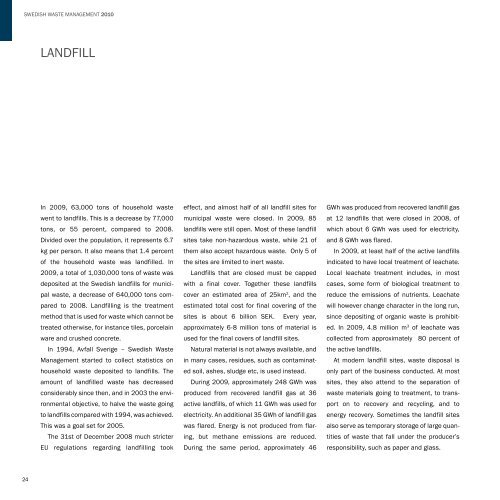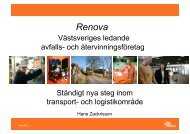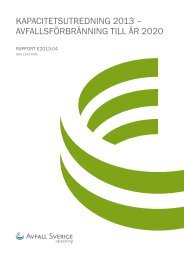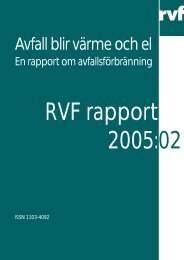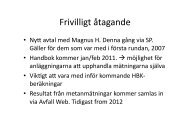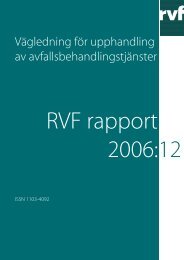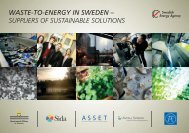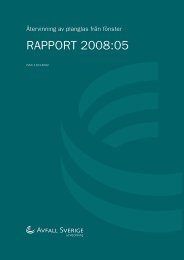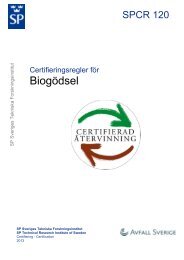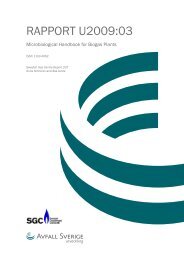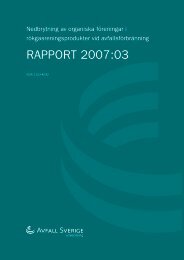SWEDISH WASTE MANAGEMENT |2010 - Avfall Sverige
SWEDISH WASTE MANAGEMENT |2010 - Avfall Sverige
SWEDISH WASTE MANAGEMENT |2010 - Avfall Sverige
Create successful ePaper yourself
Turn your PDF publications into a flip-book with our unique Google optimized e-Paper software.
<strong>SWEDISH</strong> <strong>WASTE</strong> <strong>MANAGEMENT</strong> 2010<br />
LANDFILL<br />
In 2009, 63,000 tons of household waste<br />
went to landfills. This is a decrease by 77,000<br />
tons, or 55 percent, compared to 2008.<br />
Divided over the population, it represents 6.7<br />
kg per person. It also means that 1.4 percent<br />
of the household waste was landfilled. In<br />
2009, a total of 1,030,000 tons of waste was<br />
deposited at the Swedish landfills for municipal<br />
waste, a decrease of 640,000 tons compared<br />
to 2008. Landfilling is the treatment<br />
method that is used for waste which cannot be<br />
treated otherwise, for instance tiles, porcelain<br />
ware and crushed concrete.<br />
In 1994, <strong>Avfall</strong> <strong>Sverige</strong> – Swedish Waste<br />
Management started to collect statistics on<br />
household waste deposited to landfills. The<br />
amount of landfilled waste has decreased<br />
considerably since then, and in 2003 the environmental<br />
objective, to halve the waste going<br />
to landfills compared with 1994, was achieved.<br />
This was a goal set for 2005.<br />
The 31st of December 2008 much stricter<br />
EU regulations regarding landfilling took<br />
effect, and almost half of all landfill sites for<br />
municipal waste were closed. In 2009, 85<br />
landfills were still open. Most of these landfill<br />
sites take non-hazardous waste, while 21 of<br />
them also accept hazardous waste. Only 5 of<br />
the sites are limited to inert waste.<br />
Landfills that are closed must be capped<br />
with a final cover. Together these landfills<br />
cover an estimated area of 25km 2 , and the<br />
estimated total cost for final covering of the<br />
sites is about 6 billion SEK. Every year,<br />
approximately 6-8 million tons of material is<br />
used for the final covers of landfill sites.<br />
Natural material is not always available, and<br />
in many cases, residues, such as contaminated<br />
soil, ashes, sludge etc, is used instead.<br />
During 2009, approximately 248 GWh was<br />
produced from recovered landfill gas at 36<br />
active landfills, of which 11 GWh was used for<br />
electricity. An additional 35 GWh of landfill gas<br />
was flared. Energy is not produced from flaring,<br />
but methane emissions are reduced.<br />
During the same period, approximately 46<br />
GWh was produced from recovered landfill gas<br />
at 12 landfills that were closed in 2008, of<br />
which about 6 GWh was used for electricity,<br />
and 8 GWh was flared.<br />
In 2009, at least half of the active landfills<br />
indicated to have local treatment of leachate.<br />
Local leachate treatment includes, in most<br />
cases, some form of biological treatment to<br />
reduce the emissions of nutrients. Leachate<br />
will however change character in the long run,<br />
since depositing of organic waste is prohibited.<br />
In 2009, 4.8 million m 3 of leachate was<br />
collected from approximately 80 percent of<br />
the active landfills.<br />
At modern landfill sites, waste disposal is<br />
only part of the business conducted. At most<br />
sites, they also attend to the separation of<br />
waste materials going to treatment, to transport<br />
on to recovery and recycling, and to<br />
energy recovery. Sometimes the landfill sites<br />
also serve as temporary storage of large quantities<br />
of waste that fall under the producer’s<br />
responsibility, such as paper and glass.<br />
24


